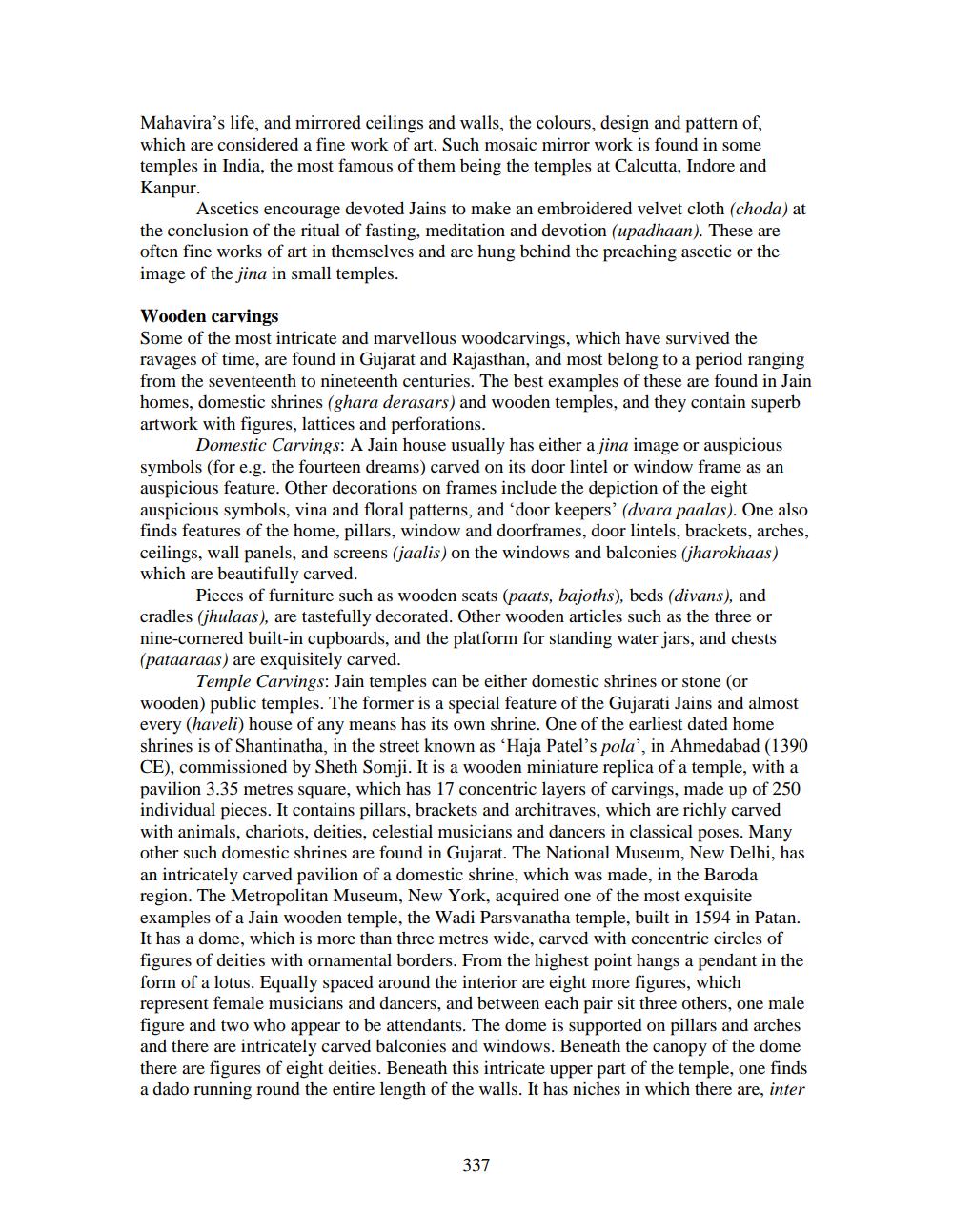________________
Mahavira's life, and mirrored ceilings and walls, the colours, design and pattern of, which are considered a fine work of art. Such mosaic mirror work is found in some temples in India, the most famous of them being the temples at Calcutta, Indore and Kanpur.
Ascetics encourage devoted Jains to make an embroidered velvet cloth (choda) at the conclusion of the ritual of fasting, meditation and devotion (upadhaan). These are often fine works of art in themselves and are hung behind the preaching ascetic or the image of the jina in small temples.
Wooden carvings Some of the most intricate and marvellous woodcarvings, which have survived the ravages of time, are found in Gujarat and Rajasthan, and most belong to a period ranging from the seventeenth to nineteenth centuries. The best examples of these are found in Jain homes, domestic shrines (ghara derasars) and wooden temples, and they contain superb artwork with figures, lattices and perforations.
Domestic Carvings: A Jain house usually has either a jina image or auspicious symbols (for e.g. the fourteen dreams) carved on its door lintel or window frame as an auspicious feature. Other decorations on frames include the depiction of the eight auspicious symbols, vina and floral patterns, and 'door keepers' (dvara paalas). One also finds features of the home, pillars, window and doorframes, door lintels, brackets, arches, ceilings, wall panels, and screens (jaalis) on the windows and balconies (jharokhaas) which are beautifully carved.
Pieces of furniture such as wooden seats (paats, bajoths), beds (divans), and cradles (jhulaas), are tastefully decorated. Other wooden articles such as the three or nine-cornered built-in cupboards, and the platform for standing water jars, and chests (pataaraas) are exquisitely carved.
Temple Carvings: Jain temples can be either domestic shrines or stone (or wooden) public temples. The former is a special feature of the Gujarati Jains and almost every (haveli) house of any means has its own shrine. One of the earliest dated home shrines is of Shantinatha, in the street known as 'Haja Patel's pola', in Ahmedabad (1390 CE), commissioned by Sheth Somji. It is a wooden miniature replica of a temple, with a pavilion 3.35 metres square, which has 17 concentric layers of carvings, made up of 250 individual pieces. It contains pillars, brackets and architraves, which are richly carved with animals, chariots, deities, celestial musicians and dancers in classical poses. Many other such domestic shrines are found in Gujarat. The National Museum, New Delhi, has an intricately carved pavilion of a domestic shrine, which was made, in the Baroda region. The Metropolitan Museum, New York, acquired one of the most exquisite examples of a Jain wooden temple, the Wadi Parsvanatha temple, built in 1594 in Patan. It has a dome, which is more than three metres wide, carved with concentric circles of figures of deities with ornamental borders. From the highest point hangs a pendant in the form of a lotus. Equally spaced around the interior are eight more figures, which represent female musicians and dancers, and between each pair sit three others, one male figure and two who appear to be attendants. The dome is supported on pillars and arches and there are intricately carved balconies and windows. Beneath the canopy of the dome there are figures of eight deities. Beneath this intricate upper part of the temple, one finds a dado running round the entire length of the walls. It has niches in which there are, inter
337




